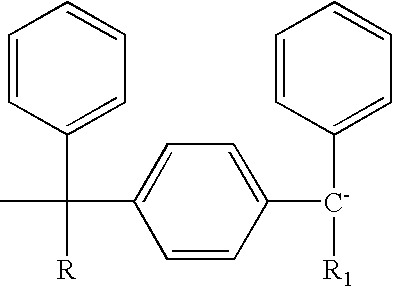End-capped polymer chains and products thereof
a polymer chain and end-cap technology, applied in the field of end-cap polymer chains, can solve the problems of inconvenient methods, and achieve the effect of preventing premature termination of living macroanion
- Summary
- Abstract
- Description
- Claims
- Application Information
AI Technical Summary
Benefits of technology
Problems solved by technology
Method used
Image
Examples
example 1
[0081]All chemical purifications and acrylate polymerizations are carried out under high vacuum condition (−6 mbar). 1.17 g (2.06×10−5 mol) of α,ω-1,1-diphenylethylene end-functionalized polyisobutylene (Mn=56800, see above) in 250 mL of hexane is stirred over calcium hydride for 24 hours. The polymer solution is then filtered to remove calcium hydride. The hexane solvent is evaporated, and 100 mL of tetrahydrofuran are added to the remaining polymer. This polymer solution is then added to a reactor equipped with a stirrer. 1,1-diphenylhexyllithium in tetrahydrofuran (see above) is added into the reactor dropwise until the color of the polymer solution changes from colorless to yellowish. The amount of 1,1-diphenylhexyllithium used for this purpose is 0.0010 g (4.1×10−6 mol). The polymer solution is subsequently cooled down to −78° C. with vigorous stirring. After 10 minutes at this temperature, 0.0090 g of n-butyllithium (1.4×10−4 mol) in 27.5 mL of hexane is added into the reactor...
example 2
[0083]1.60 g (2.8×10−5 mol) of α,ω-1,1-diphenylethylene end-functionalized polyisobutylene (Mn=56800, see above) in 200 mL of hexane is stirred over calcium hydride for 24 hours. The polymer solution is then filtered to remove calcium hydride. Solvent is evaporated, and 100 mL of tetrahydrofuran is added to the remaining polymer. The polymer solution is then added to a reactor equipped with a stirrer, and 1,1-diphenylhexyllithium in tetrahydrofuran (see above) is added into reactor dropwise until the color of the polymer solution changes from colorless to yellowish. The amount of 1,1-diphenylhexyllithium used for this purpose is 0.0010 g (4.1×10−6 mol). The polymer solution is subsequently cooled to −78° C. with vigorous stirring. After 10 minutes at this temperature, 0.0122 g of n-butyllithium (1.9×10−4 mol) in 40 mL of hexane is added into the reactor. After an additional 12 hours, the polymer solution is heated to 40° C. and kept at this temperature for 1 hour. The polymer soluti...
example 3
[0085]1.96 g (3.45×10−5 mol) of α,ω-1,1-diphenylethylene end-functionalized polyisobutylene (Mn=56800, see above) in 300 mL of hexane is stirred over calcium hydride for 24 hours. The polymer solution is then filtered to remove calcium hydride. The solvent is evaporated and 130 mL of tetrahydrofuran are added to the remining polymer. The resulting polymer solution is then added to a reactor equipped with a stirrer. 1,1-diphenylhexyllithium in tetrahydrofuran (see above) is then added into reactor dropwise until the color of the polymer solution changes from colorless to yellowish. The amount of 1,1-diphenylhexyllithium used for this purpose is 0.0030 g (1.2×10−5 mol). Afterwards, the polymer solution is cooled down to −78° C. with vigorous stirring. After 10 minutes at this temperature, 0.0160 g of n-butyllithium (2.5×10−4 mol) in 40 mL of hexane is added into the reactor. 2 hours later, the polymer solution is heated to 40° C. and kept at this temperature for 1 hour. Then, the poly...
PUM
| Property | Measurement | Unit |
|---|---|---|
| polydispersity index | aaaaa | aaaaa |
| polydispersity index | aaaaa | aaaaa |
| flow rate | aaaaa | aaaaa |
Abstract
Description
Claims
Application Information
 Login to View More
Login to View More - R&D
- Intellectual Property
- Life Sciences
- Materials
- Tech Scout
- Unparalleled Data Quality
- Higher Quality Content
- 60% Fewer Hallucinations
Browse by: Latest US Patents, China's latest patents, Technical Efficacy Thesaurus, Application Domain, Technology Topic, Popular Technical Reports.
© 2025 PatSnap. All rights reserved.Legal|Privacy policy|Modern Slavery Act Transparency Statement|Sitemap|About US| Contact US: help@patsnap.com



